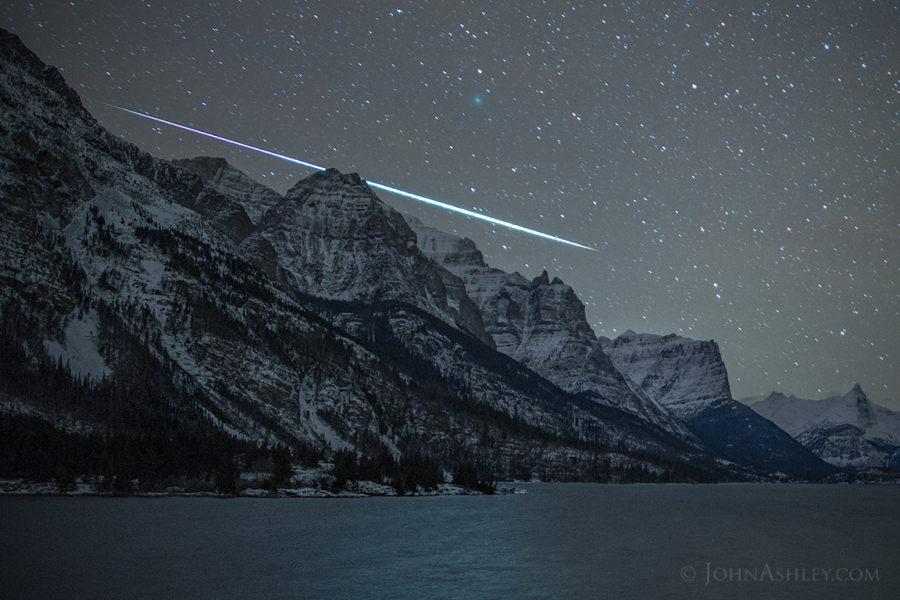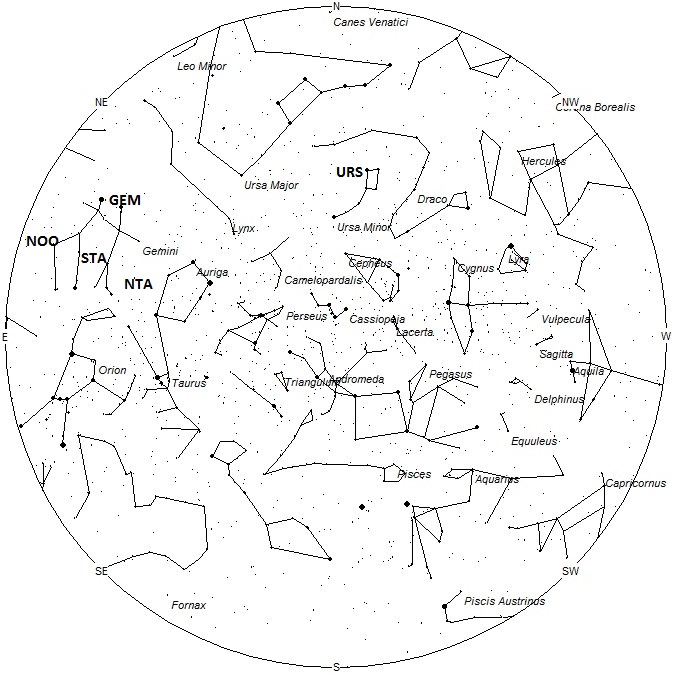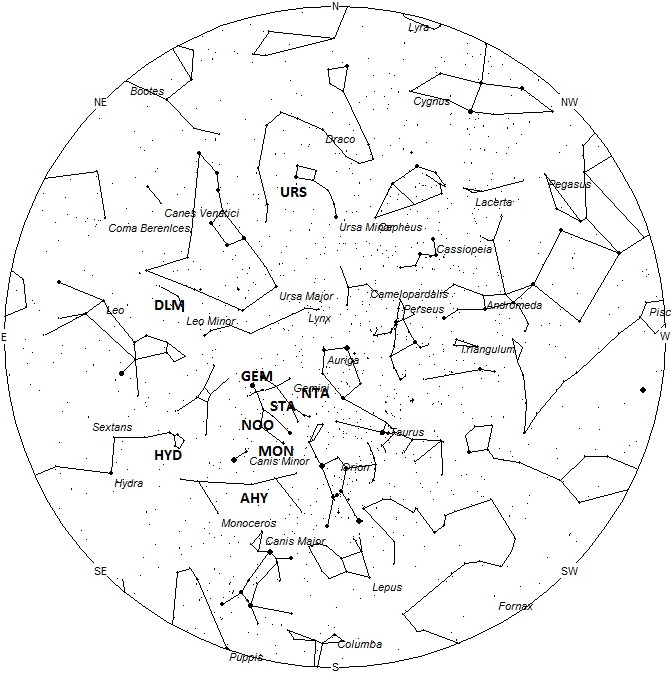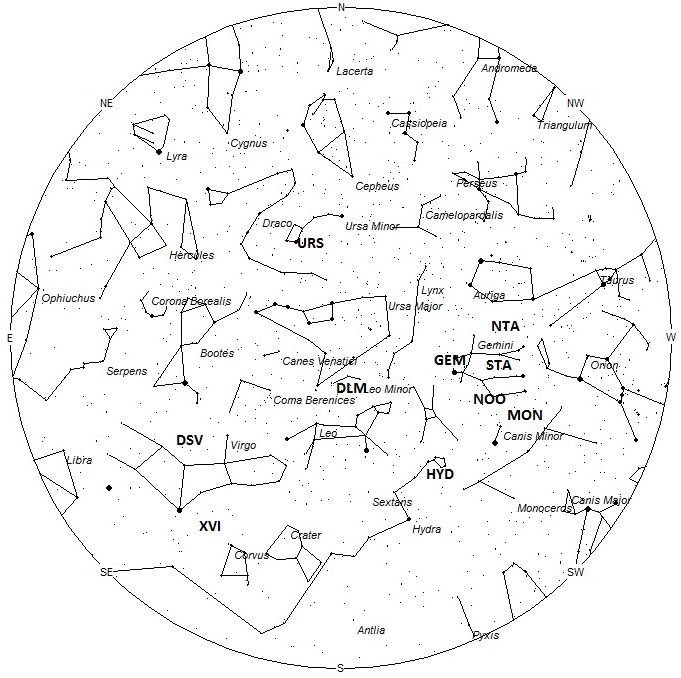
The radiant (the area of the sky where meteors appear to shoot from) positions and rates listed below are exact for Saturday night/Sunday morning December 15/16. These positions do not change greatly day to day so the listed coordinates may be used during this entire period. Most star atlases (available at science stores and planetariums) will provide maps with grid lines of the celestial coordinates so that you may find out exactly where these positions are located in the sky. A planisphere or computer planetarium program is also useful in showing the sky at any time of night on any date of the year. Activity from each radiant is best seen when it is positioned highest in the sky, either due north or south along the meridian, depending on your latitude. It must be remembered that meteor activity is rarely seen at the radiant position. Rather they shoot outwards from the radiant so it is best to center your field of view so that the radiant lies near the edge and not the center. Viewing there will allow you to easily trace the path of each meteor back to the radiant (if it is a shower member) or in another direction if it is a sporadic. Meteor activity is not seen from radiants that are located far below the horizon. The positions below are listed in a west to east manner in order of right ascension (celestial longitude). The positions listed first are located further west therefore are accessible earlier in the night while those listed further down the list rise later in the night.
These sources of meteoric activity are expected to be active this week.
The last of the Northern Taurids (NTA) are expected this week. The large radiant is located at 06:08 (092) +32, which is located in eastern Auriga, 3 degrees northwest of the 4th magnitude star known as kappa Aurigae. This position is close to the Southern Taurids so great care must be taken in separating these meteors. You must have the two radiants near the center of your field of view to properly differentiate these sources. Current rates would be 2 per hour as seen from the northern hemisphere and 1 per hour as seen from south of the equator. These meteors may be seen all night long but the radiant is best placed near midnight local standard time (LST) when it lies on the meridian and is located highest in the sky. With an entry velocity of 28 km/sec., the average Northern Taurid meteor would be of slow velocity.
The Southern Taurids (STA) are active from a large radiant centered near 06:22 (095) +25. This position lies in western Gemini, 4 degrees east of the 3rd magnitude star known as Mebsuta (epsilon Geminorum). These meteors may be seen all night long but the radiant is best placed near midnight LST when it lies on the meridian and is located highest in the sky. Current rates would be 1 per hour as seen from the northern hemisphere and less than 1 per hour as seen from south of the equator. With an entry velocity of 27 km/sec., the average Southern Taurid meteor would be of slow velocity.
The Monocerotids (MON) are active from November 28th through December 27th with the peak activity occurring on December 13th. The radiant is currently located at 07:04 (106) +08. This position lies in eastern Monoceros, 5 degrees west of the 3rd magnitude star known as Gomeisa (beta Canis Minoris). This position is only 7 degrees south of the radiant of the November Orionids so care must be take to distinguish between the two. Current rates should be near 2 per hour no matter your location. The Monocerotids are best seen near 0100 LST when the radiant lies highest above the horizon. At 41 km/sec. the Monocerotids produce mostly meteors of medium velocity.
The last of the November Orionids (NOO) should be seen this weekend from a radiant located at 07:15 (109) +15. This area of the sky lies in southern Gemini, 1 degree south of the 4th magnitude star known as lambda Geminorum. This area of the sky is best placed in the sky near 0100 LST, when it lies highest above the horizon. This stream is active from November 7 through December 17, with maximum activity occurring on November 29. Rates should be less than 1 per hour no matter your location. With an entry velocity of 43 km/sec., most activity from this radiant would be of medium speed.
The alpha Hydrids (AHY) were discovered by Dr. Peter Brown and associates using the meteoroid stream survey provided by the Canadian Meteor Orbit Radar. This long duration stream is active for a month with maximum activity occurring on January 3rd. The current position lies at 07:21 (110) -04, which places the radiant in eastern Monoceros, 10 degrees southwest of the brilliant zero magnitude star known as Procyon (alpha Canis Minoris). Current rates should be less than 1 per hour no matter your location. The alpha Hydrids are best seen near 0100 LST when the radiant lies highest above the horizon. At 43 km/sec. the alpha Hydrids produce mostly meteors of medium velocity.
The Geminids (GEM) are active from December 1-22, with peak activity occurring on December 14th. This weekend the radiant is located near 07:41 (115) +32. This position lies in northern Gemini, just east of the 2nd magnitude star known as Castor (alpha Geminorum). Rates this weekend should be near 20 per hour as seen from the northern hemisphere and 2-3 in the southern hemisphere . Hourly rates will fall by approximately 50% each night until the shower ends. At 34 km/sec. the Geminids produce mostly meteors of medium velocity.
The Sigma Hydrids (HYD) are active from November 24 through December 21, with maximum activity occurring on December 6. The radiant is currently located at 08:48 (132) +01 , which places it in extreme western Hydra, 2 degrees southeast of the 4th magnitude star known as eta Hydrae. These meteors are best seen near 0400 LST when the radiant lies highest above the horizon. Hourly rates are expected to be near 1 per hour no matter your location. With an entry velocity of 62 km/sec., most activity from this radiant would be of swift speed.
The December Leonis Minorids (DLM) are a shower of long duration active from December 6th through January 18th. Maximum occurs near December 21st when rates may reach 3 an hour. The radiant is currently located at 10:22 (156) +32. This position lies in central Leo Minor, 5 degrees south of the 4th magnitude star known as beta Leonis Minoris. These meteors are best seen near 0400 LST when the radiant lies highest above the horizon. At 63 km/sec. the December Leonis Minorids produce mostly swift meteors.
The December chi Virginids (XVI) was discovered by Japanese observers using the data of SonotaCo. This source is active from December 16-24 with maximum activity occurring on the 19th. The current radiant location is at 12:42 (191) -11, which places it in south-central Virgo, 10 degrees west of the bright star known as Spica (alpha Virginis). Current rates would most likely be less than 1 per hour no matter you location. These meteors are best seen during the last dark hour before dawn, when the radiant lies highest above the horizon in a dark sky. At 69 km/sec. the December Chi Virginids would produce mostly swift meteors.
The December Sigma Virginids (DSV) was discovered by John Greaves using the data of SonotaCo. IMO video cameras confirmed that this source is active during the month of December. Peak rates occur near December 14th. The current radiant location is at 13:30 (203) +05 which places it in northern Virgo, 5 degrees north of the 3rd magnitude star known as Heze (zeta Virginis). Current hourly rates should be near 1 shower member no matter you location. These meteors are best seen during the last dark hour before dawn, when the radiant lies highest above the horizon in a dark sky. At 68 km/sec. the December Sigma Virginids would produce mostly swift meteors.
The Ursids (URS) should be active later in the the week with maximum activity occurring on December 22. The radiant is currently located at 13:44 (206) +76, which places it in western Ursa Minor, 3 degrees west of the faint star known as 5 Ursae Minoris. This area of the sky is circumpolar for most of the northern hemisphere and lies highest above the horizon in a dark sky just before dawn. Rates will be low all week and unfortunately the peak coincides with the full moon this month . At 33 km/sec. the Ursids would produce mostly medium speed meteors.
As seen from the mid-northern hemisphere (45N) one would expect to see approximately 11 sporadic meteors per hour during the last hour before dawn as seen from rural observing sites. Evening rates would be near 2 per hour. As seen from the tropical southern latitudes (25S), morning rates would be near 9 per hour as seen from rural observing sites and 1 per hour during the evening hours. Locations between these two extremes would see activity between the listed figures. Evening rates are reduced during this period due to moonlight.
The list below offers the information from above in tabular form. Rates and positions are exact for Saturday night/Sunday morning except where noted in the shower descriptions.
| SHOWER | DATE OF MAXIMUM ACTIVITY | CELESTIAL POSITION | ENTRY VELOCITY | CULMINATION | HOURLY RATE | CLASS |
| RA (RA in Deg.) DEC | Km/Sec | Local Standard Time | North-South | |||
| Northern Taurids (NTA) | Nov 11 | 06:08 (092) +32 | 28 | 00:00 | 2 – 1 | II |
| Southern Taurids (STA) | Oct 30-Nov 02 | 06:22 (095) +25 | 27 | 00:00 | 1 – <1 | II |
| Monocerotids (MON) | Dec 13 | 07:04 (106) +08 | 41 | 01:00 | 1 – 1 | II |
| November Orionids (NOO) | Nov 29 | 07:15 (109) +15 | 43 | 01:00 | 2 – 2 | II |
| alpha Hydrids (AHY) | Jan 03 | 07:21 (110) -04 | 43 | 01:00 | <1 – <1 | IV |
| Geminids (GEM) | Dec 14 | 07:41 (115) +32 | 34 | 02:00 | 20 – 3 | I |
| sigma Hydrids (HYD) | Dec 06 & Dec 18 | 08:48 (132) +01 | 61 | 03:00 | 1 – 1 | II |
| December Leonis Minorids (DLM) | Dec 21 | 10:22 (156) +32 | 63 | 04:00 | 3 – 1 | II |
| December chi Virginids (XVI) | Dec 19 | 12:42 (191) -11 | 69 | 06:00 | <1 – <1 | IV |
| December sigma Virginids (DSV) | Dec 13 | 13:30 (203) +05 | 66 | 07:00 | 1 – 1 | IV |
| Ursids (URS) | Dec 22 | 13:44 (206) +76 | 33 | 07:00 | <1 – <1 | I |







 You saw something bright and fast? Like a huge shooting star? Report it: it may be a fireball.
You saw something bright and fast? Like a huge shooting star? Report it: it may be a fireball.  You counted meteors last night? Share your results with us!
You counted meteors last night? Share your results with us!  You took a photo of a meteor or fireball? You have a screenshot of your cam? Share it with us!
You took a photo of a meteor or fireball? You have a screenshot of your cam? Share it with us!  You caught a meteor or fireball on video? Share your video with us!
You caught a meteor or fireball on video? Share your video with us!